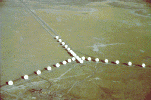Low Frequency Data Reduction at the VLA: Namir Kassim and
Rick Perley have written up a guide to dealing with 74/330 MHz VLA data,
and the first draft is here! This is a working draft; please send
comments or suggestions to Joseph Lazio
(lazio@rsd.nrl.navy.mil).
It's also available as
postscript [346k]). NRAO Electronic News Bulletin:
NRAO has recently instituted an electronic news bulletin that is
intended to supplement the regular
NRAO Newsletter.
This is an email service consisting of short descriptions of news
stories, articles, meeting announcements, and so forth, together with
web links to longer descriptions. If you wish to receive these
e-mailings, please sign
up! OBSERVE bug: Past versions of OBSERVE (possibly
all before the most recent release on 16 December 1998) had a bug
which affected spectral line observers using the "no change" option
(//FIN card). If you don't know what this is, you haven't used it!
Choosing the "no change" option on the Local Oscillator page should
produce a //FIN card in the resulting OBSERVE file; instead, no
//FI card of any type was produced. This sets the local oscillators to
their default settings, appropriate for wide-band continuum work but
seldom desirable for spectral line observations. We have checked
the past year's worth of OBSERVE files for this problem; only one file
had this problem, and that observer has already been contacted. OBSERVE
itself is now fixed (16Dec98), and the new corrected version 4.0.4 can be
fetched from our anonymous
ftp site. Please check with Michael Rupen
mrupen@nrao.edu if you
wish further details.
Very strong RFI near 1622 MHz:
The Iridium constellation of satellites has begun transmitting almost
continually at 1622 MHz. This has serious consequences for 1612 MHz
OH observations, and for continuum observations near 1622 MHz.
|


![[NRAO]](nraologo1.gif)
![[AUI]](auilogo.gif)
![[NSF]](nsflogo1.gif)